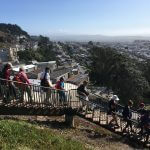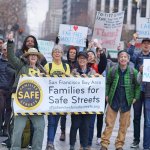New state report echoes the need to set speed limits based on safety
We know that the faster a vehicle is going, the more likely its driver is to cause a traffic crash – and to severely injure or kill the person who is hit. That’s why we must reduce speeds.
But in Walk SF’s work to win lower speed limits and speed safety cameras, we’ve hit frustrating walls. One is the fact that current California law requires speed limits to be set based on how fast most drivers are going, not on what’s needed to keep people safe. This outdated approach is known as the “85th percentile”.
In November, hundreds of you sent emails to members of the state’s Zero Traffic Fatalities Task Force asking for cities like San Francisco to be able to set speed limits based on safety, not speed.
This week, the Zero Traffic Fatalities Task Force released its much-anticipated report outlining their recommendations for creating safer roadways, including looking at the 85th percentile. Reading the report’s 60-plus pages, it’s clear your voices were heard and that some of the frustrating walls are starting to crack.
Though the report’s policy recommendations are not as bold as we’d like, it does set the stage for new legislation that can fundamentally change our streets to be safer for all.
How? First, the report recognizes that traffic fatalities increase with vehicle speed. It also states that the 85th percentile approach to speed limits is not only outdated, but not based on scientific data and must change to combat rising traffic injuries and fatalities. And it highlights the need for speed limits to be set with full consideration – and prioritization – of people walking and biking, especially seniors and children.
This probably isn’t earth-shattering to anyone reading this, but it’s incredibly important that these three points have been acknowledged by the state for meaningful legislation to move forward (and hopefully quickly) both to change the 85th percentile approach and allow speed safety cameras on our streets.
Regarding the specific recommendations in the report about the 85th percentile, they would go a long way to improve things by:
- Increasing by how much speed limits can be lowered from the 85th percentile speed on high-injury networks and roadways that have high concentrations of vulnerable road users.
- Allowing areas with a high volume of road users and frequent street crossings to set lower speed limits without a traffic survey, like the way school zones are currently approached.
- Allowing state and local agencies to post speed limits below 25 MPH when supported by a traffic survey.
We need these recommendations to become the law in California, plus pass other legislation to give communities every possible tool to end severe and fatal traffic crashes including speed safety cameras.
So what’s next? Walk San Francisco will quickly work with state leaders to champion the bills that will #SlowOurStreets and save lives. And as soon as there’s a bill to pass, we’ll definitely need your help – so be sure you’re on our email list for updates.




